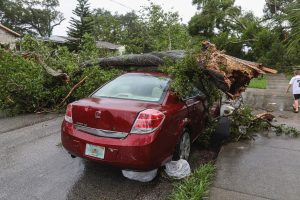
By Heather N. Kolich, ANR Agent, UGA Extension Forsyth County
Our recent Georgia Arbor Day celebrations gave us opportunities to appreciate the many benefits of trees. These majestic plants are essential elements for many ecosystems.
They provide habitat and nourishment for wildlife and other plants, reduce soil erosion, and influence the weather. On the human side, trees give us beauty and shade, improve our physical and mental health, and provide economic benefits. But all like all living and structural things, trees can fail, and a failing tree can become a hazard.
What makes a tree hazardous?
In forest and natural environments, dying trees drop limbs, fall or collapse, and continue to contribute to the ecosystem. In settings where people are present, however, falling limbs and trees can cause injury, death, damage, and economic loss. If a failing tree or part of that tree is likely to fall on a person, pet, livestock, house, car, fence, or other target, it is a hazardous tree.
Causes of tree failure
Age, injury, defects, disease, weather, and insects can transition a tree from vigorous health to declining health or sudden death. With aging trees, decline usually progresses toward death over a span of years. Trees may struggle to overcome minor to moderate injuries for years, as well, but catastrophic injuries from storms or construction damage cause rapid death. Disease is often a secondary factor that hastens tree decline, since aging, injured, and otherwise stressed trees are less able to resist or overcome disease pathogens. Pest insects like boring beetles are attracted to stressed trees.
Identifying hazardous trees
Some signs of hazardous trees are easy to see. Things to look for include:
- Leaning — Trees that lean 30 degrees or more with a target in their path of fall are hazardous. Leaning trees may also show stress cracks or buckling bark on the trunk, cracks in the soil surface around the tree, or decay at or near the base of the tree.
- Cracks, cankers, or cavities – Large openings in the trunk or major branches indicate significant areas of decay that weaken tree structure.
- Defects – Forked trunks are structurally weak. Dampness held in the fork leads to rot, with further weakens the fork until one side splits off and falls. Branches with weak connections can also shear away from the trunk.
- Dieback – Branches that don’t leaf out at the ends and leafless or browning upper branches could indicate a failing root system, decay, or systemic fungus that blocks movement of water from the roots to branches.
Dead, broken, and hanging branches – Root system problems can cause branch death. Dying branches on one side of the tree could be a symptom of trunk damage or root injury on that side. Dead and broken branches pose a falling hazard.
- Mushrooms – Growing on the trunk, branches, or ground around a tree, mushrooms are a sure sign of decay within the tree.
- Standing dead trees – Although snags offer habitat to various wildlife species, these whole or partial standing dead trees are decomposing and subject to sudden collapse.
- Trees that failed to fall – Falling and wind-tossed trees and branches can get hung up in the branches of nearby trees. These are falling hazards as natural or other forces will eventually dislodge them and bring them to the ground.

Mitigating damage
Trees in advanced decline – such as those with mushrooms – or obvious instability should be removed immediately. A certified arborist can assess, advise, and perhaps recommend treatment for other tree issues.